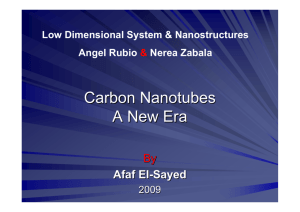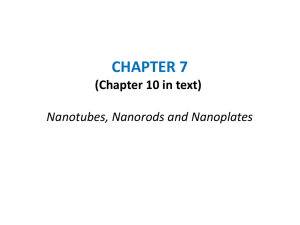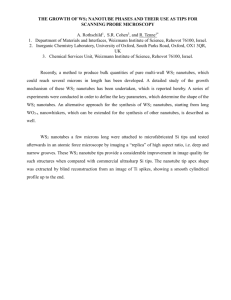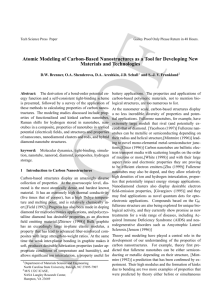Education and Outreach: Nanotechnology
advertisement
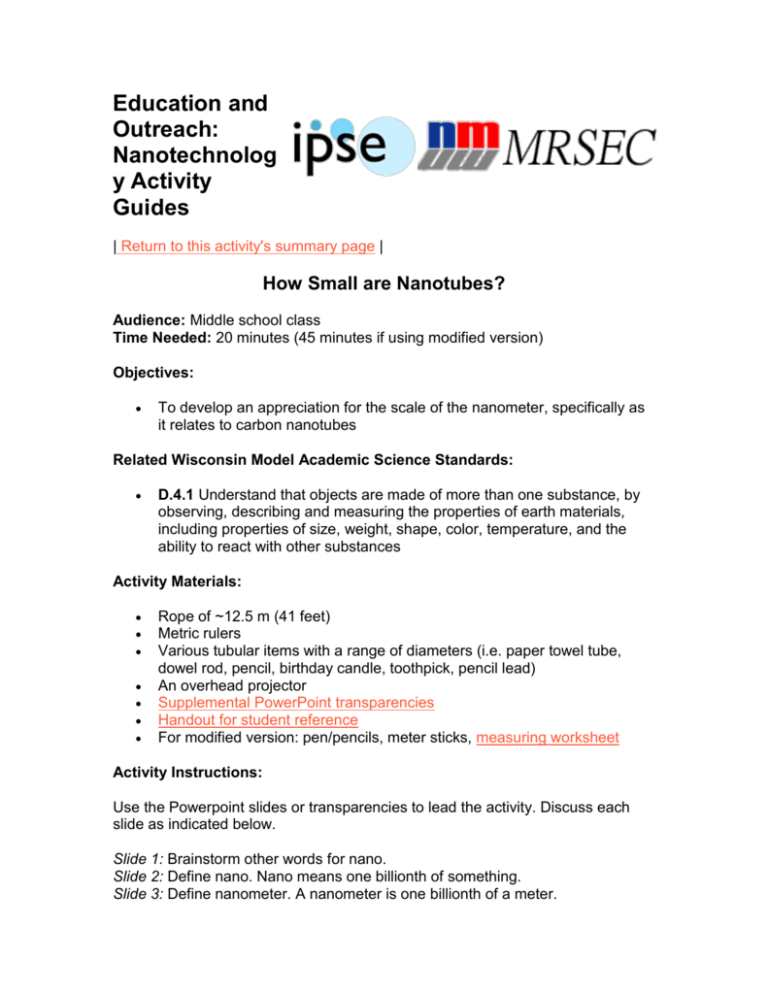
Education and Outreach: Nanotechnolog y Activity Guides | Return to this activity's summary page | How Small are Nanotubes? Audience: Middle school class Time Needed: 20 minutes (45 minutes if using modified version) Objectives: To develop an appreciation for the scale of the nanometer, specifically as it relates to carbon nanotubes Related Wisconsin Model Academic Science Standards: D.4.1 Understand that objects are made of more than one substance, by observing, describing and measuring the properties of earth materials, including properties of size, weight, shape, color, temperature, and the ability to react with other substances Activity Materials: Rope of ~12.5 m (41 feet) Metric rulers Various tubular items with a range of diameters (i.e. paper towel tube, dowel rod, pencil, birthday candle, toothpick, pencil lead) An overhead projector Supplemental PowerPoint transparencies Handout for student reference For modified version: pen/pencils, meter sticks, measuring worksheet Activity Instructions: Use the Powerpoint slides or transparencies to lead the activity. Discuss each slide as indicated below. Slide 1: Brainstorm other words for nano. Slide 2: Define nano. Nano means one billionth of something. Slide 3: Define nanometer. A nanometer is one billionth of a meter. Slide 4: Talk about the abbreviations used by the International System of Units and what they mean. Slide 5: The nanometer length is an important unit of measure for the field of nanotechnology. Carbon nanotubes, for instance, usually have a diameter of about 4 nm. Slide 6: (optional) Carbon nanotubes can be observed by electron microscopy. Slide 7: Compare to other small tubular things, like hair. Slide 8: Have students measure the diameter of their wrists for comparison. Slide 9: Compare diameter of our wrists to the diameter of hair. Slide 10: If you magnify the hair 100,000 times it would have a 4m diameter. Slide 11: Construct a 4m diameter circle with the rope. How big would a carbon nanotube be in comparison? Slide 12: Is it the size of a wrapping paper tube, dowel rod, pencil, birthday candle, toothpick, or pencil lead? Slide 13: The circle has a diameter of 4m, so the “nanotube” would have a diameter of 0.4mm. Answer – pencil lead. Modification Options The measuring section of the activity can be expanded using the worksheet. Have students get into groups or three to four and give each group a meter stick and a copy of the worksheet. Ask the students to use the meter stick to find two to three things that are approximately the size of a meter, a centimeter, and a millimeter. If they know objects that are about a micrometer and a nanometer in size, they may also fill in those blanks. The students should be encouraged to be creative and even to write down things outside the classroom, such as something from their room at home. They are welcome to make approximations (an object does not have to be exactly one meter tall to count). After they have found several objects for a unit, they should also draw a picture of one of the objects in the box on the right. Give them about 20 minutes for the activity. After they are finished, discuss some of the examples people found for each unit. Required Background Information: Most students will be familiar with diamond and graphite and may even know that these materials are made up of carbon. Diamond is the hardest substance found in nature (a diamond ring can scratch glass easily), but graphite is one of the softest (pencils use graphite to make a black mark, and graphite is also often used as a lubricant to allow two surfaces to slide past each other freely). Both graphite and diamonds are made up of only of carbon atoms, but the atoms in each of the materials are arranged very differently (diamond = tetragonal; graphite = hexagonal sheet, each atom bonded to three others). The differences between these two types of carbon arise at the nanoscale - when the structures of carbon atoms have different arrangements. Imagine taking one of the graphite sheets that makes up pencil lead and rolling it into a cylinder – this is a new form of carbon called a nanotube. The structures of nanotubes can be correlated with their physical properties such as: Mechanical properties (tensile strength): Based on small-scale experiments and theoretical calculations, a one-inch thick rope of carbon nanotubes is predicted to be 100 times stronger than steel and 1/6 the weight of steel. Thermal conductivity properties: Carbon nanotubes have very good thermal conductivity properties. Electrical conductivity properties: Some nanotubes have semi conducting properties while others have metallic properties depending on their structure. For more information about carbon nanotubes, see the Carbon Nanotubes Activity Guide. Supplemental Materials: Transparencies (pdf) Handout: Student Reference (pdf) Handout: Worksheet (pdf) References: The Nanotube Site - http://nanotube.msu.edu Authors: IPSE Interns: Julia Bickler, Wendy deProphetis, Manisha Ghorai, LJ Janowski, Ed Kabara, Nancy Karuri, Yvonne Kao, Laura Kopplin, Melissa Kurth, Lauren Sammel, Erin Schmidt, Naveen Varma IPSE Leadership Team: Wendy C. Crone, Amy Payne, Greta Zenner, and Tom Derenne | Return to this activity's summary page | The Nanotechnology Activity Guides are a product of the Materials Research Science and Engineering Center and the Internships in Public Science Education Project of the University of Wisconsin - Madison. Funding provided by the National Science Foundation.




